Mar 03, 2011
Researchers Crack the Mystery of the Missing Sunspots
By Dr. Tony Phillips
March 2, 2011: In 2008-2009, sunspots almost completely disappeared for two years. Solar activity dropped to hundred-year lows; Earth’s upper atmosphere cooled and collapsed; the sun’s magnetic field weakened, allowing cosmic rays to penetrate the Solar System in record numbers. It was a big event, and solar physicists openly wondered, where have all the sunspots gone?
Now they know. An answer is being published in the March 3rd edition of Nature.
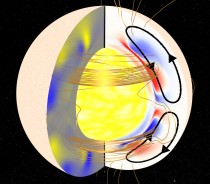
In this artistic cutaway view of the sun, the Great Conveyor Belt appears as a set of black loops connecting the stellar surface to the interior. Credit: Andres Munoz-Jaramillo of the Harvard CfA. “Plasma currents deep inside the sun interfered with the formation of sunspots and prolonged solar minimum,” says lead author Dibyendu Nandi of the Indian Institute of Science Education and Research in Kolkata. “Our conclusions are based on a new computer model of the sun’s interior.”
For years, solar physicists have recognized the importance of the sun’s “Great Conveyor Belt.” A vast system of plasma currents called ‘meridional flows’ (akin to ocean currents on Earth) travel along the sun’s surface, plunge inward around the poles, and pop up again near the sun’s equator. These looping currents play a key role in the 11-year solar cycle. When sunspots begin to decay, surface currents sweep up their magnetic remains and pull them down inside the star; 300,000 km below the surface, the sun’s magnetic dynamo amplifies the decaying magnetic fields. Re-animated sunspots become buoyant and bob up to the surface like a cork in water - voila! A new solar cycle is born.
For the first time, Nandi’s team believes they have developed a computer model that gets the physics right for all three aspects of this process--the magnetic dynamo, the conveyor belt, and the buoyant evolution of sunspot magnetic fields.
“According to our model, the trouble with sunspots actually began in back in the late 1990s during the upswing of Solar Cycle 23,” says co-author Andres Munoz-Jaramillo of the Harvard-Smithsonian Center for Astrophysics. “At that time, the conveyor belt sped up.”
The fast-moving belt rapidly dragged sunspot corpses down to sun’s inner dynamo for amplification. At first glance, this might seem to boost sunspot production, but no. When the remains of old sunspots reached the dynamo, they rode the belt through the amplification zone too hastily for full re-animation. Sunspot production was stunted.

Sunspot cycles over the last century (enlarged). The blue curve shows the cyclic variation in the number of sunspots. Red bars show the cumulative number of sunspot-less days. The minimum of sunspot cycle 23 was the longest in the space age with the largest number of spotless days. Credit: Dibyendu Nandi et al.
Later, in the 2000s, according to the model, the Conveyor Belt slowed down again, allowing magnetic fields to spend more time in the amplification zone, but the damage was already done. New sunspots were in short supply. Adding insult to injury, the slow moving belt did little to assist re-animated sunspots on their journey back to the surface, delaying the onset of Solar Cycle 24.
“The stage was set for the deepest solar minimum in a century,” says co-author Petrus Martens of the Montana State University Department of Physics.
Colleagues and supporters of the team are calling the new model a significant advance.
“Understanding and predicting solar minimum is something we’ve never been able to do before---and it turns out to be very important,” says Lika Guhathakurta of NASA’s Heliophysics Division in Washington, DC.

Three years ago on March 2, 2008, the face of the sun was featureless--no sunspots. Credit: SOHO/MDI While Solar Max is relatively brief, lasting a few years punctuated by episodes of violent flaring, over and done in days, Solar Minimum can grind on for many years. The famous Maunder Minimum of the 17th century lasted 70 years and coincided with the deepest part of Europe’s Little Ice Age. Researchers are still struggling to understand the connection.
One thing is clear: During long minima, strange things happen. In 2008-2009, the sun’s global magnetic field weakened and the solar wind subsided. Cosmic rays normally held at bay by the sun’s windy magnetism surged into the inner solar system. During the deepest solar minimum in a century, ironically, space became a more dangerous place to travel. At the same time, the heating action of UV rays normally provided by sunspots was absent, so Earth’s upper atmosphere began to cool and collapse. Space junk stopped decaying as rapidly as usual and started accumulating in Earth orbit. And so on.
Nandi notes that their new computer model explained not only the absence of sunspots but also the sun’s weakened magnetic field in 08-09. “It’s confirmation that we’re on the right track.”
Next step: NASA’s Solar Dynamics Observatory (SDO) can measure the motions of the sun’s conveyor belt - not just on the surface but deep inside, too. The technique is called helioseismology; it reveals the sun’s interior in much the same way that an ultrasound works on a pregnant woman. By plugging SDO’s high-quality data into the computer model, the researchers might be able to predict how future solar minima will unfold. SDO is just getting started, however, so forecasts will have to wait.
Indeed, much work remains to be done, but, says Guhathakurta, “finally, we may be cracking the mystery of the spotless sun.”
Credits: This research was funded by NASA’s Living With a Star Program and the Department of Science and Technology of the Government of India.
Feb 28, 2011
Attack of the Climate Change Lawyers
By Doug Hoffman
One indication of how mature a scam has become is when it starts to attract the attention of trial lawyers. The recent spate of natural disasters has reminded people everywhere of how capricious the forces that govern our world can be. Floods in particular have destroyed crops, houses and lives in Australia, Pakistan, China and Brazil. While climate science remains too immature to blame humans for exacerbating the forces of nature by emitting greenhouse gases, there are ominous signs that climate change alarmists are becoming desperate enough to enlist the unholiest of allies in their cause—lawyers. An editorial in the February 20, 2011, edition of Nature Geoscience cites two new studies which claim to affirm the anthropogenic global warming/extreme weather link, opening the door for future litigation.
Previously a marginal or totally ignored issue, climate-change litigation is rapidly emerging as a new legal frontier. Some believe hundreds of billions of dollars are at stake and that compensation for losses inflicted by man-made global warming could potentially make tobacco and asbestos damage settlements look like pocket change. In a world where a thin majority of people believe the threat of global warming is over hyped, any legal action based on damages resulting from anthropogenic global warming faces significant challenges. But times may be changing.
In an editorial piece entitled “The challenge of extremes,” the journal Nature Geoscience has taken results from two statistical, model based studies as proof positive there is human culpability in recent extreme weather results. “One reveals that human-induced emissions have contributed to the observed intensification of extreme rainfall events over parts of the Northern Hemisphere,” the article states. “Another quantifies the impact of anthropogenic emissions on the risk of the floods experienced in the UK in autumn 2000.”
UK flooding in the year 2000. Was it global warming?.
The two referenced papers both appear in the February 16 edition of Nature (Nature Geoscience is part of the same group of publications). The first is “Human contribution to more-intense precipitation extremes,” authored by Seung-Ki Min, Xuebin Zhang, Francis W. Zwiers, and Gabriele C. Hegerl. In their study, data from the Hadley Centre global land-based climate extremes dataset (HadEX), covering the period 1951-2003, is analyzed in an effort to find an anthropogenic “fingerprint.” The HadEX data contained two sets of measurements: observations of annual maximum daily and five-day precipitation amounts, RX1D and RX5D respectively. As the paper explains, the measured data was compared with model generated datasets.
Here we show that human-induced increases in greenhouse gases have contributed to the observed intensification of heavy precipitation events found over approximately two-thirds of data-covered parts of Northern Hemisphere land areas. These results are based on a comparison of observed and multi-model simulated changes in extreme precipitation over the latter half of the twentieth century analysed with an optimal fingerprinting technique. Changes in extreme precipitation projected by models, and thus the impacts of future changes in extreme precipitation, may be underestimated because models seem to underestimate the observed increase in heavy precipitation with warming.
Simulated daily precipitation data were obtained from the Coupled Model Intercomparison Project Phase 3 (CMIP3) archive and from other modeling centers. “A total of 19 anthropogenic forcing (ANT, greenhouse gases and sulphate aerosols as major factors) simulations are available from six models,” states the report. “In addition, 16 simulations conducted under natural (solar and volcanic activity) plus anthropogenic forcings (ALL) are also available from five models."…
After sorting through the supplementary data, some observations can be made regarding this study and its results are as follows:
•The use of ALL forcings in the models generated a lower probablity of extreme weather.
•Using only the anthropogenic forcings (ANT) skewed the results higher.
•In either case, the model results were about half of the observed rates.
•The individual models were not in good agreement with each other.
•The claim to have created a reliable AGW “fingerprint” is merely statistical slight of hand.
The fingerprint was created by observing “low-frequency patterns” in the statistical comparison of the different model runs. Unsurprisingly, the authors found the AGW only runs had a more pronounced pattern than the more realistic runs utilizing natural forcings as well as anthropogenic ones. Not that either set of model results came close to matching reality.
No matter, using already biased models, further biased by restricting forcing inputs, yields “proof” that humans are causing extreme precipitation events to increase…
The second study, “Anthropogenic greenhouse gas contribution to flood risk in England and Wales in autumn 2000,” authored by Pardeep Pall et al., is much narrower in scope, concentrating on finding a smoking gun for the UK floods of 2000. Naturally, as the “facts” become more specific the results become more slippery.
Using publicly volunteered distributed computing, we generate several thousand seasonal-forecast-resolution climate model simulations of autumn 2000 weather, both under realistic conditions, and under conditions as they might have been had these greenhouse gas emissions and the resulting large-scale warming never occurred. Results are fed into a precipitation-runoff model that is used to simulate severe daily river runoff events in England and Wales (proxy indicators of flood events). The precise magnitude of the anthropogenic contribution remains uncertain, but in nine out of ten cases our model results indicate that twentieth-century anthropogenic greenhouse gas emissions increased the risk of floods occurring in England and Wales in autumn 2000 by more than 20%, and in two out of three cases by more than 90%.
The methodology seems to be “add up erroneous and unsupportable model results until the aggregate gives you an answer close to the one you want.” This sounds more like a television advertisement than science: two out of three climate models respond this way! Using an “oversimplified thermodynamic treatment” of the hydrological cycle, the authors calculated what the “reduction in observed precipitation extremes” would have been without global warming during the autumn of 2000.
Note that they assumed, a priori, that less global warming would mean less precipitation when even the IPCC has stated that some areas will become dryer and some wetter as global temperatures increase. This is partly based on reduced sea surface temperatures that the authors admit cannot be calculated: “Instead we derived this warming from estimates in prior studies.” They then let the public crank out a few thousand hypothesis confirming model runs and pronounce humans at fault for the flooding. To make everything sound more scientific they muck about with some data manipulation to arrive at a calculated fraction of attributable risk (FAR).
For the comparison, they apply the Clausius-Clapeyron relation, “which at mid-latitudes typically dictates a change in daily precipitation extremes of approximately 6.5% per degree temperature change.” Based on this simple estimation, they scale down the distribution of observed precipitation according to the mean England and Wales portion of the attributable twentieth-century surface warming. “Since the relation only applies to precipitation extremes we only scale down precipitation above the 90th percentile,” they state. Imagine trying to explain all this to a jury.
As suggested in Nature News online, insurers will take note of these and other emerging studies, as will those developing policies for adapting to climate change. “This has immense importance not just as a further justification for emissions reduction, but also for adaptation planning,” says Michael Oppenheimer, a climate-policy researcher at Princeton University in New Jersey, who was not involved in the studies reported here.
While the “evidence” for expanding climate change litigation is gathering momentum, wining a global warming based damages suit is still a legal long shot. The latest evidence is in and the picture for prospective claimants is not looking good. The two new studies reviewed here are both based on questionable assumptions, reliant on biased computer models and, in the end, totally dependent on obfuscating data manipulation and statistical trickery. Will the legal community rise to take the bait? Here is how the NatGeo editorial summed up the case against humanity:
But a risk increase by as little as 20%, at a 90% level of probability, may not be deemed sufficient in a courtroom to claim compensation. And it is not entirely clear yet how the probabilistic nature of the argument would work in legal frameworks that were originally built around proof of causation. Nor is it obvious how the blame could be distributed between various emitters of greenhouse gases. That said, it seems that the science is far enough advanced for the legal profession to become interested.
At one time, science used to require proof of causation itself. The reason for this shift in legal emphasis, from international agreements to more localized litigation, is because efforts to craft a new treaty following the expiration of the Kyoto accord have proven fruitless. Claims of economic injustice by developing nations have met with increasing resistance. The developed nations have basically told the underdeveloped ones that playing the victim wont work and that members of the OECD will not pay a disproportionate burden in the quest to lower greenhouse gas emissions.
Read much more on The Resilient Earth.
Feb 26, 2011
Blog and video by John Coleman on why the global warming science has failed humanity
By John Coleman
The following blog appears on the KUSI Coleman’s Corner blog. There is a 30 minute plus video featuring John’s view of the issue. Enjoy.
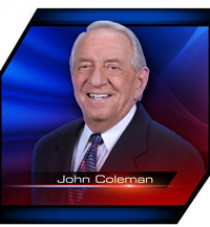
There is a story I heard that I keep thinking about. It really underlines the problem I have in trying to counter the bad science behind the global warming scare predictions. So here is the story:
A group of over 200 environmentalists were in an auditorium listening to a symposium about climate change, i.e. global warming or climate disruption. One of the speakers asked, “If I could instantly produce a genie with a magic wand to stand here before you today. And if, that genie could wave his magic wand and wall-la....carbon dioxide would no longer be a greenhouse gas that produced uncontrollable global warming....How many in this room would be happy, satisfied and pleased?” Two people out of two hundred hesitatingly raised their hands. Of the others, some smirked, some laughed and some yelled out, “No, no. Hell no.”
I cannot testify that this event actually occurred. But, I heard it as though it was a truthful report. In any case it haunts me because it demonstrates what I perceive to be something akin to the actual state of affairs in our efforts to quiet the Algorian scare predictions about the consequences of global warming. There are large segments of the population that believe the global warming pronouncements. They have heard them over and over again from people they trust and respect, in school, on television, in the news and in their communities. They have become “believers”, not unlike those who believe in a set of religious beliefs. All good Democrats believe in global warming, after all, it is the science of one of their key heroes, former Vice President and Senator Al Gore. And all good environmentalists are aboard the global warming band wagon. And, for all of them, the Agenda is what is important. Their Agenda is to eliminate fossil fuels and the internal combustion engine from our civilization. The carbon dioxide, CO2, thing is simply the means to the end. And if the means is not true; who cares. It is only the Agenda that is important. To all of these people, my effort to debunk the CO2 greenhouse gas science is irrelevant.
When I present my scientific arguments in a speech, their common reaction, “so what” and they ask me, even if you are right, isn’t the change to clean energy still the best move for our society? When I make my argument in response, that I also favor alternate energy, but that it will be thirty to fifty years before it can replace fossil fuels as the primary source of power for our civilization and that alternate energy in its current state of development is not economically viable, they doubt my facts. They have heard the hype and bought the dream without stopping to absorb the reality.
Next, when they realize they have not persuaded me to join their point of view, they challenge me with “And, what if it turns out that you are wrong and Al Gore is right? Your argument could cost us everything as climate change makes the Earth unlivable. So let’s just eliminate the greenhouse gases as insurance.” I argue back that the insurance will financially destroy us, wreck our way of life and that because I am right about the science, the move to alternate energy will not make an iota difference in our climate.
At this point, they dismiss me a stupid, old heretic.
My only option is to keep trying. That is why I make the new videos like the one posted on February 22nd. But, I am frustrated and not optimistic about penetrating our scientific institutions and organizations that are in the control of their well paid scientists and persuading them to reconsider the roll of carbon dioxide and accept climate reality. What are the odds they will “see the light” and abandon their richly rewarding global warming positions? Nil, I fear.
It appears, as of now, victory, if it were to come, would be on a political level, not a scientific one. Just as “the climate according to Al Gore” has become the Democrat Party mantra, “global warming is not real” has become the rally call of the Republican Party. As a Journalist (I am a member of the television news team at KUSI-TV) I try hard to avoid taking political positions. For instance, I pass on invitations to speak at political events even when handsome stipends are offered.
So I keep focused on the bad science behind global warming. If my team (There are over 31,000 scientists on my team) can make headway in correcting the science, then I will be happy to let the politics, environmentalism and alternate energy movement fight the policy battles without me.
Feb 26, 2011
Freemon Dyson jousts with biased ‘science editor’
ICECAP NOTE: Freemon Dyson was interviewed via email by the Independent’s chief alarmist journalist Steve Connor with results posted in a piece titled: Letters to a heretic. Steve started out repeating the litany of AGW dogma and then challenging Freeman to respond. Freemon does an admirable job trying to focus Steve on the real issues and not playing in the warmist sandbox with its shards of broken glass. The editor introduces the interview with “...our science editor, Steve Connor, asks the Princeton scholar why he’s one of the few true intellectuals to be so dismissive of the global-warming consensus”.
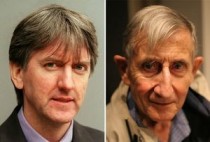
Connor left (of course) and Dyson right (yes indeed)
Here are some excerpts:
Freemon to Steve Conner
“Of course I am not expecting you to agree with me. The most I expect is that you might listen to what I am saying. I am saying that all predictions concerning climate are highly uncertain. On the other hand, the remedies proposed by the experts are enormously costly and damaging, especially to China and other developing countries. On a smaller scale, we have seen great harm done to poor people around the world by the conversion of maize from a food crop to an energy crop. This harm resulted directly from the political alliance between American farmers and global-warming politicians.
Unfortunately the global warming hysteria, as I see it, is driven by politics more than by science. If it happens that I am wrong and the climate experts are right, it is still true that the remedies are far worse than the disease that they claim to cure.
I wish that The Independent would live up to its name and present a less one-sided view of the issues.
and
“When I was in high-school in England in the 1930s, we learned that continents had been drifting according to the evidence collected by Wegener. It was a great mystery to understand how this happened, but not much doubt that it happened. So it came as a surprise to me later to learn that there had been a consensus against Wegener. If there was a consensus, it was among a small group of experts rather than among the broader public. I think that the situation today with global warming is similar. Among my friends, I do not find much of a consensus. Most of us are sceptical and do not pretend to be experts. My impression is that the experts are deluded because they have been studying the details of climate models for 30 years and they come to believe the models are real. After 30 years they lose the ability to think outside the models. And it is normal for experts in a narrow area to think alike and develop a settled dogma. The dogma is sometimes right and sometimes wrong. In astronomy this happens all the time, and it is great fun to see new observations that prove the old dogmas wrong.
Unfortunately things are different in climate science because the arguments have become heavily politicised. To say that the dogmas are wrong has become politically incorrect. As a result, the media generally exaggerate the degree of consensus and also exaggerate the importance of the questions.
Connor to Freemon:
“One of the problems I have with the climate “sceptics” is that they keep changing their arguments. First they say that there is no such thing as global warming, thereby dismissing all the many thousands of records of land and sea temperatures over the past century or so. Then they say that carbon dioxide emissions are not causing the Earth to warm up, thereby defying basic physics...To continue to report on “both sides” as you suggest is rather like ringing up the Flat Earth Society and asking them to comment on new discoveries in plate tectonics.”
Freemon to Connor:
“Your last message just repeats the same old party line that we have many good reasons to distrust. You complain that people who are sceptical about the party line do not agree about other things. Why should we agree? The whole point of science is to encourage disagreement and keep an open mind. That is why I blame The Independent for seriously misleading your readers. You give them the party line and discourage them from disagreeing.
With all due respect, I say good-bye and express the hope that you will one day join the sceptics. Scepticism is as important for a good journalist as it is for a good scientist.”
ICECAP NOTE: The claim that we keep changing our arguments is cognitive dissonance to the extreme. We will soon post a list of 10 warmist claims that have failed. We have compiled a list of 30, but will start with the big ten. In almost all cases, the warmists have turned it around suggesting their failure proves their success. Recall their claims of failed claims of warmer, snowless winters as recent as 2007 now turned around and used as proof of greenhouse warming.
Feb 24, 2011
The Recent Drop In The Sea Surface Temperatures Of U.S. Coastal Waters
By Bob Tisdale
Bob does an excellent job tracking climate factors on his site. Here is an example with excerpts of a post on cooling of US ‘coastal waters’.
This post illustrates the recent drop in the SST anomalies of the U.S. coastal waters. We’ll represent this subset with the coordinates of 20N-50N, 130W-65W. I’ve used those coordinates in at least one earlier post about the SST Anomalies of U.S. “Coastal” Waters. Figure 1 is the December 2010 Reynolds OI.v2 SST anomaly map with those coordinates highlighted. The cooling appears to be an exaggerated response to the 2010/11 La Nina.

Figure 1
Figure 2 is the Reynolds OI.v2-based time-series graph for this subset. After the two-month flattening in September and October 2010, at approximately -0.24 deg C, the SST anomalies dropped more than 0.65 deg C by January 2011. The January 2011 reading for the U.S. Coast Waters is the lowest on record for the satellite-based Reynolds Oi.v2 SST dataset.
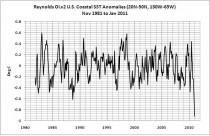
Figure 2
Note: This is not a post about global sea surface temperature (SST) anomalies, nor is it a post about the SST anomalies of the individual ocean basins. For those refer to the January 2011 SST Anomaly Update.
Figures 3, 4, and 5 show the long-term SST anomalies for the U.S. Coastal Waters using the HADISST, ERSST.v3b, and HADSST2 datasets. They provide a different perspective on the magnitude of the recent drop. For the HADISST and ERSST.v3b datasets, one has to go back to the April 1971 to find similar SST anomalies, and back to July 1933 with HADSST2 data.
The weekly data for this subset, Figure 6, show that the SST anomalies are rebounding. I’ll add this dataset to the monthly update for a few months to assure it rebounds fully.
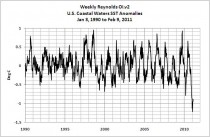
Figure 6
SOURCE
The map and all data presented in this post are available through the KNMI Climate Explorer.
|










